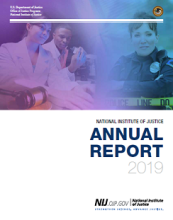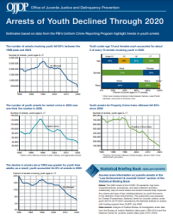Offenses
Gender-Based Violence and the Latinx Community
Review the YouTube Terms of Service and the Google Privacy Policy
National Institute of Justice Fiscal Year 2019 Annual Report
Just Science Podcast: Just Autopsy Results and Crime Scene Reconstruction
An exploratory network analysis of hot people and places
Delaware Opioid Metric Intelligence Project, Final Report
Identifying online risk markers of hard-to-observe crimes through semi-inductive triangulation: The case of human trafficking in the United States
An Introduction to Forensic Genetic Genealogy Technology for Forensic Science Service Providers
Ionic liquid-solvated near infrared dyes for detection of trace blood spatter in textiles under ambient lighting conditions
Understanding the Criminal Justice and Health Care Needs of Latinx Victims of Hate Crime and Bias Victimization
Evaluation of the Occurrence and Associative Value of NonIdentifiable Fingermarks on Unfired Ammunition in Handguns for Evidence Supporting Proof of Criminal Possession, Use and Intent
Real-Time Sample-Mining and Data-Mining Approaches for the Discovery of Novel Psychoactive Substances (NPS)
Improving Strategies for Investigating & Prosecuting Hate Crimes: A National Yet Local Approach
Breaking the School-to-Prison Pipeline: Implications of Removing Police from Schoolsfor Racial and Ethnic Disparities in the Justice System
Impact of Drug Market Pulling Levers Policing on Neighborhood Violence: An Evaluation of the High Point Drug Market Intervention
Exposing School Employee Sexual Abuse and Misconduct: Shedding Light on a Sensitive Issue
Just Science Podcast: Just a Curious Case of Print Persistence
Gun Wars and Community Terrorization: Investigating Longitudinal Gang Violence in New Jersey from a Networked Perspective
Arrests of Youth Declined Through 2020
What’s Possible with Rapid DNA Technology?
NIJ scientist Tracey Johnson joins science writer Sarah Michaud in this episode. They discuss Rapid DNA technology, and Tracey explains the complexities of this technology – its pitfalls and its possibilities.
Reading and Resources from NIJ:
Tribal Crime, Justice, and Safety (Part 2)
Tribal Crime, Justice, and Safety (Part 2)
Stacy Lee Reynolds and Christine (Tina) Crossland continue their discussion of tribal crime, justice, and safety, including how Native American persons experience crime victimization at higher rates than non-Native people and the jurisdictional complexities in responding to tribal crime, justice, and safety. Read the transcript.
Listen to the first half of Stacy and Tina’s discussion.
Reading and Resources from NIJ
Tribal-Researcher Capacity Building Grants









